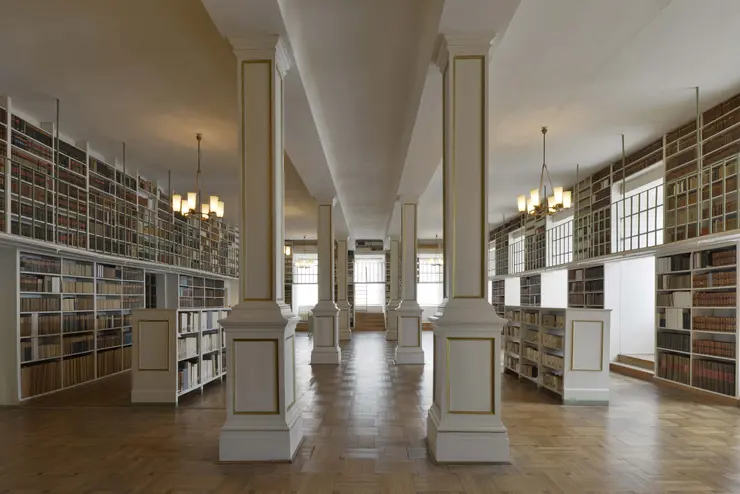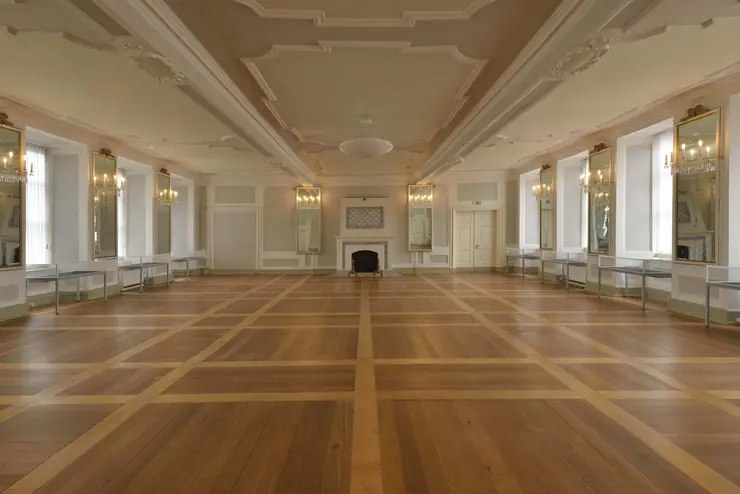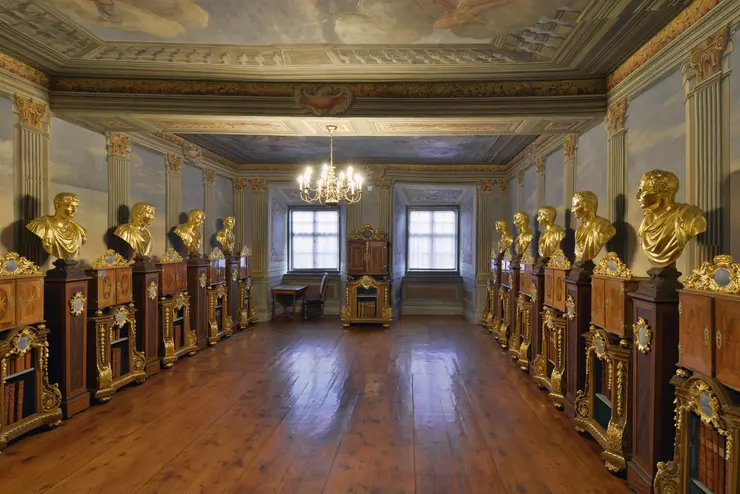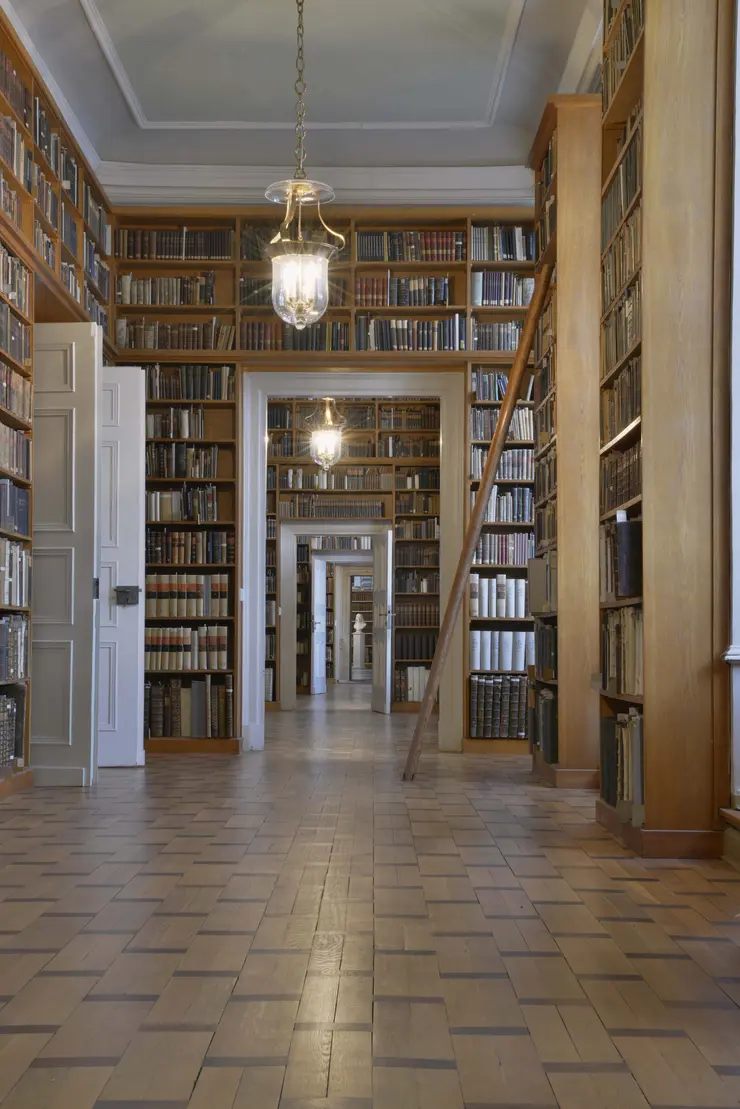Historic Showrooms
Today, the Gotha Research Library occupies a total of about 4,000 square metres of the east wing of Friedenstein Palace. Since its foundation in 1647, the court library of the ducal house of Saxe-Gotha was located in the west tower of the palace and, after of the east tower had been consumed by flames and reconstructed, was moved there at the beginning of the 18th century. The history of the library was and is a history of expansion into the palace and adjacent areas and, in recent decades, also into virtual space with its digital collections. Initially confined to one room in the west tower and then to the second floor in the east tower, other floors gradually followed, so that by 1900 the library occupied all four floors of the east tower. After the Soviet Union returned the holdings in 1956, the library was placed on the first and second floors of the east tower and the entire east wing. Today, it occupies half of the ground floor of the east wing, most of the first and second floors of the east wing and east tower, as well as the third floor of the east tower and parts of the page house belonging to the palace. This includes staff rooms and areas open to the public. As part of the renovation of Friedenstein Palace, the library will be expanded over the next few years to include the parts of the ground floor of the east wing and east tower that it does not yet use.
Library room
The original High Hall in the east tower, called the "Hall of Vanity" by Duke Ernest I (1601–1675), comprised the second and third floors without an intermediate ceiling and was used for festive occasions. Between the 20 windows hung tall paintings of the ducal family created by the Gotha court painter Michael Käseweiß and the Weimar court painter Christian Richter. Later, forty panels depicting the life of Christ and the pagans (or the Antichrist) were added. These had previously been in the church of Wilhelmsburg Castle in Schmalkalden. A few years after the "iconoclasm" that occurred there in 1608, they were given to Duke Ernst I. as a gift. The biblical verse "All is vanity" from the Preacher Solomon ran around the edge of the ceiling. In 1678, the entire tower was destroyed by a smouldering fire in one of the chimney shafts, resulting in the loss of all furnishings.
The rebuilding of the tower began in 1684. In 1703, the library found its new home in the hall completed on the second floor. The furnishings were kept simple. Only the pillars and the wooden shelves standing in the room were framed in gold. Here and in the adjoining three rooms, the books were arranged thematically according to the system developed by Veit Ludwig von Seckendorff in the 1650s. The hall served as a showroom for travellers visiting the library and as a reading and study area for the library staff and other users. Today, many historical journals and the extensive collection of funeral sermons are located here.
Hall of Mirrors
In the Hall of Mirrors, also referred to as the Picture Gallery, the princes originally dined with guests. In the 19th century, the hall also served as the ducal living room, as can be seen in old photographs. Today it serves as a venue for the Gotha Research Library. The annual exhibitions are held here, for example.
Historical Coin Cabinet
The Historical Coin Cabinet was established in 1713. It is one of the few coin cabinets in Europe that has survived almost completely unaltered from the early 18th century. A copper engraving in the "Gotha Numaria" by the numismatist Christian Sigismund Liebe (1687-1736) from 1730 proves the authenticity of this uniquely furnished room in its present state. In 1712, Duke Friedrich II (1676-1732) acquired the famous coin collection of Prince Anton Günther II of Schwarzburg-Arnstadt (1653-1716). It comprised more than 18,800 coins and medals from antiquity to the present day. To adequately represent this collection, the Italian fresco painter Giovanni Francesco Marchini (c. 1672-1745) designed the room in the style of the Italian quadrature that cannot be found anywhere else in Thuringia. On each of the side walls are seven double-door coin cabinets. Between them are pedestals upon which gilded plaster busts of the first twelve Roman emperors from Julius Caesar to Nero and Domitian rest. The two halves of the ceiling are painted with four allegories of the then known continents of Europe, Africa, America and Asia.
Geography Room
The magnificent Geography Room with its valuable ceiling décor and parquet flooring dates back to the 18th century. The initials adorning the ceiling, "F" and "LD" for Duke Friedrich III (1699-1772) and his wife Luise Dorothea (1710-1767), indicate that it was used as a living or social room at court. The ceiling painting features two female allegories. The one holding a compass and the floor plan of Friedenstein Palace refers to architecture. The other depicted with a mirror and a snake refers to the cardinal virtue of prudence. This is also revealed by the words on the banner "Virtus et Sapientia" (Prudence and Wisdom). This was part of the efforts of this ducal couple to self-fashion themselves as patrons of the arts and sciences. The chandelier was made in Bohemia. The parquet floor consists of eight different precious woods. The current name of the room goes back to the collections on geography that have been set up here partially since the middle of the 20th century.
Library Gallery
On the second floor of the east wing, the library gallery led the visitor through a representative collection of life-size paintings of princely figures into the library hall in the east tower. In the 18th century, the residential and social rooms of Duke Ernst II of Saxe-Gotha-Altenburg (1745–1804) and his wife Charlotte of Saxe-Meiningen (1751–1827) led off from the gallery. The elaborate design of the rooms adjacent to the gallery bears witness to this. For example, the room immediately to the left – today holding books on "Oppida" (towns) – displays an ancestral gallery of the dukes and duchesses of Meiningen. The ceiling is elaborately designed. The Labours of Hercules are depicted in the corners. The central ceiling painting depicts a landscape of ruins, framed by a representation of the "Symbolum Christianorum" (Symbol of the Christians). Another room contains two supraport paintings (now copies) by Jean-Antoine Houdon (1741–1828) with stylised portraits of Duke Friedrich III and his son Ernst II. Compared to other rooms, the gallery is rather plain and has a simple parquet floor. After the books taken to the Soviet Union as spoils of the Second World War had been returned in 1956, the gallery was furnished with bookshelves. Today they preserve literature on history.



![[Translate to English:] Ein herrschaftlicher Wohnraum aus dem 18. Jahrhundert. [Translate to English:] Wohnraum des 18. Jahrhunderts](/fileadmin/_processed_/3/f/csm_Geographiezimmer_78ad01a37f.webp)



